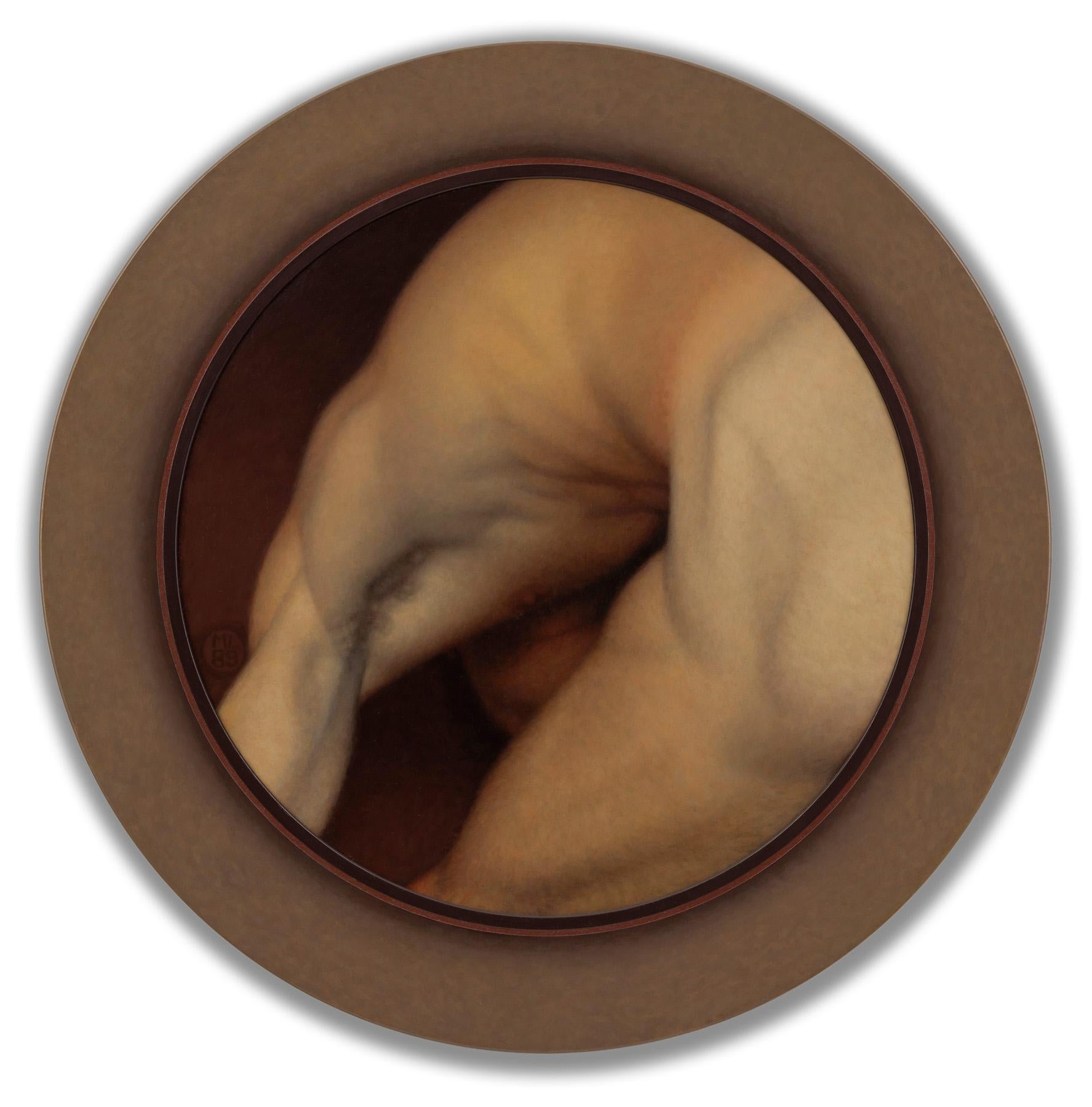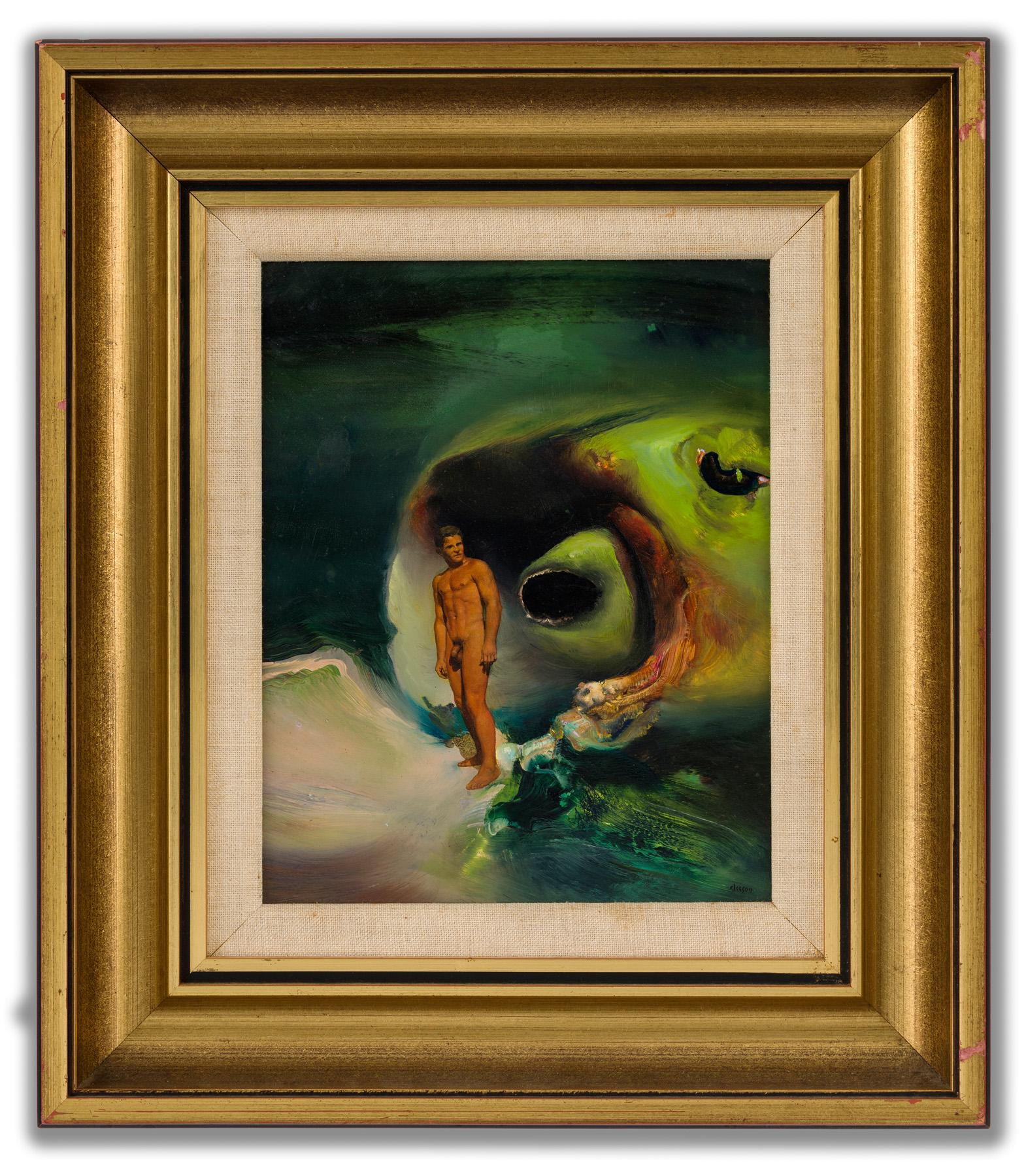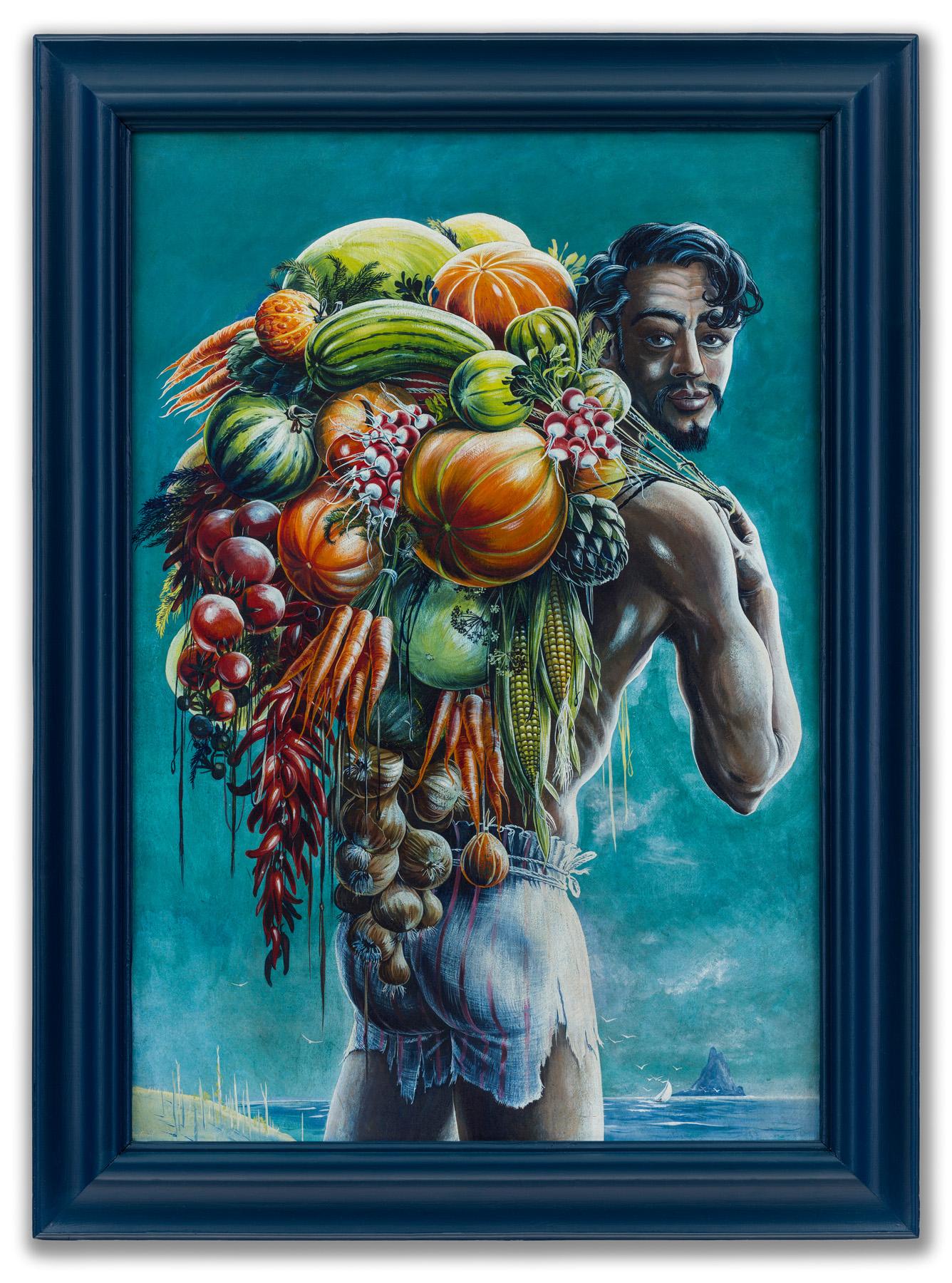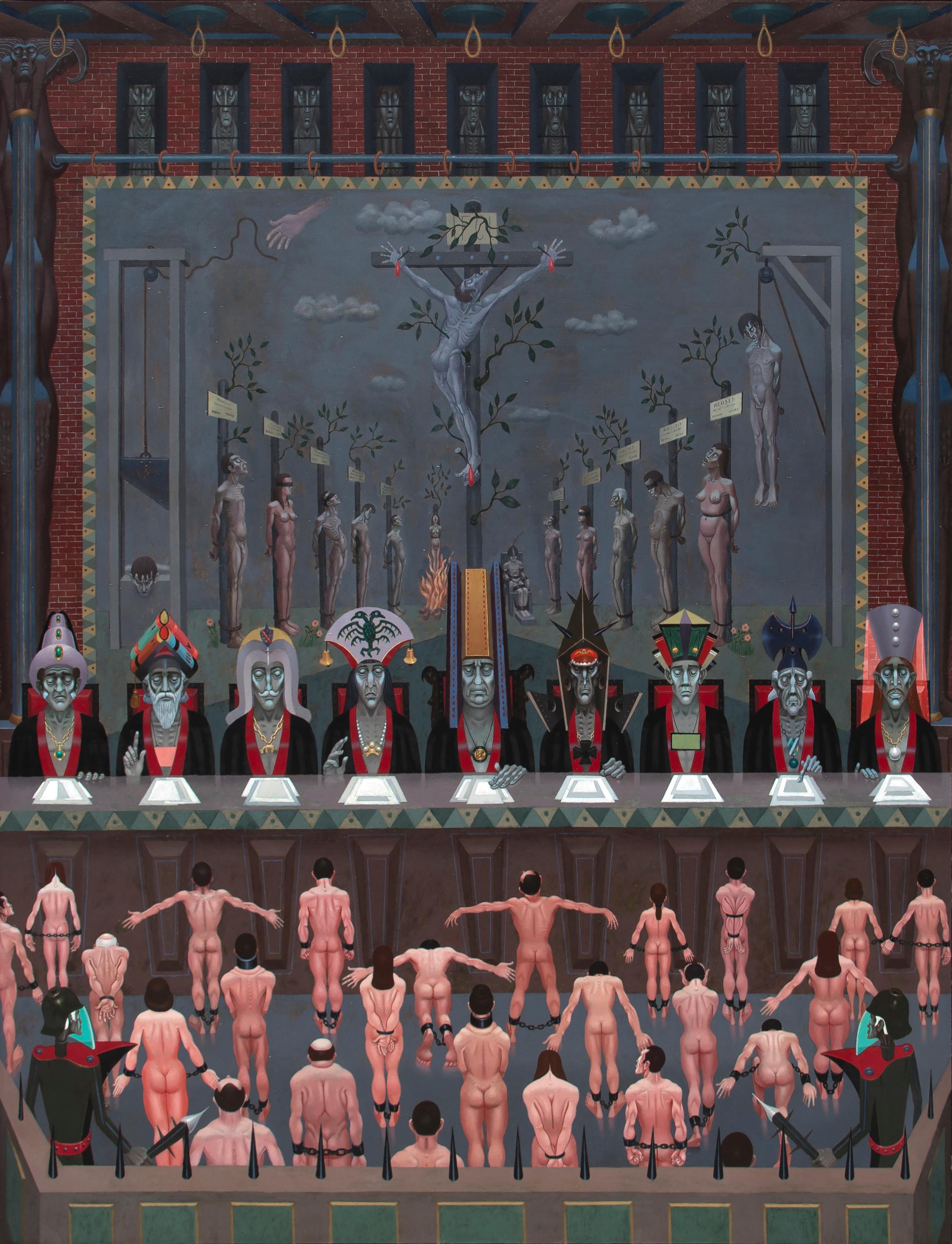Video Loading
Want more images or videos?
Request additional images or videos from the seller
1 of 12
Francis PlummerFigure in a Lanscapec.1980
c.1980
About the Item
Oil on board, 62cm x 42cm, (70cm x 50cm framed). The picture is in good condition.
Plummer trained at the Royal Academy Schools in the early 1950s, championed by Stanley Spencer and Sir Herbert Read, he was the recipient of the coveted Leverhulme Scholarship. In a mixed career which included illustration work for The National Trust, anatomical illustration for Guys Hospital and teaching, painting ran parallel to his commercial work. Plummer specialised in the medium of egg tempera, as well as oil painting, a technique little used since the frescos of the Renaissance, he often worked on a large scale, but in tremendous detail, combining Classical iconography and formal composition with visual exploration evocative of William Blake and Stanley Spencer. His principle focus is the depiction of the human form. He exhibited widely at venues including The Leicester Galleries, Leighton House Galleries and London House Galleries. Plummer’s principle focus in his output throughout his career, was the human form; primarily the nude. His work is truly original in both nature and style.
- Creator:Francis Plummer (1930 - 2019)
- Creation Year:c.1980
- Dimensions:Height: 27.56 in (70 cm)Width: 19.69 in (50 cm)Depth: 1.19 in (3 cm)
- Medium:
- Movement & Style:
- Period:
- Condition:
- Gallery Location:London, GB
- Reference Number:
About the Seller
5.0
Vetted Seller
These experienced sellers undergo a comprehensive evaluation by our team of in-house experts.
Established in 2013
1stDibs seller since 2022
- ShippingRetrieving quote...Ships From: London, United Kingdom
- Return PolicyA return for this item may be initiated within 7 days of delivery.
More From This SellerView All
- Man Reaching Down: TondoBy Michael LeonardLocated in London, GBAlkyd-oil on Masonite, signed and dated (middle left), 61cm (diam.), (83cm diam. framed). (This work was kept by the artist for his personal collection. It remained in his collection...Category
1980s Post-War Figurative Paintings
MaterialsOil, Board
- Vanitas (unfinished)By Michael LeonardLocated in London, GBAlkyd-oil on board, 81cm diam., (100cm diam framed). Although most famous for his portrait of HM Queen Elizabeth in the National Portrait Gallery, London, from the late 1970s up un...Category
Early 2000s Post-War Figurative Paintings
MaterialsBoard, Oil
- Figure in a Psychoscape IIILocated in London, GBOil on board, signed (lower right), 24.5cm x 19cm (40cm x 35cm framed). Renowned as Australia’s foremost surrealist painter and poet, James Gleeson’s o...Category
1980s Post-War Figurative Paintings
MaterialsOil, Board
- The Vegetable Seller, MauritiusBy Stuart Maxwell ArmfieldLocated in London, GBTempera on board, 87cm x 60cm (framed 106cm x 78cm). Stuart Maxwell Armfield (1916-2000) was renowned for his use of the traditional egg tempera technique, a skilled process that us...Category
1940s Post-War Nude Paintings
MaterialsEgg Tempera, Board
- MaratLocated in London, GBOil on canvas, signed and dated (lower right), 102cm x 102cm, (109cm x 109cm framed) Yankel Feather was a British painter, and a member of the Liverpool...Category
1980s Post-War Figurative Paintings
MaterialsOil, Canvas
- Against the GlassBy Michael LeonardLocated in London, GBAlkyd-oil on Masonite board, 102cm x 83cm, (124cm x 104cm framed). The painting comes directly from the artist. Michael Leonard is most probably most famous for his portrait of HM ...Category
Early 2000s Post-War Figurative Paintings
MaterialsMasonite, Alkyd
You May Also Like
- UntitledBy Nathan OliveiraLocated in Palm Desert, CAA painting by Nathan Oliveira. "Untitled" is a Bay Area Figurative Painting, oil on canvas in a brown and tan palette by American artist Nathan Oliveira. The artwork is signed in the...Category
Late 20th Century Post-War Figurative Paintings
MaterialsCanvas, Oil
- Supreme JusticeBy Irving NormanLocated in Palm Desert, CAA painting by Irving Norman. "Supreme Justice" is a social surrealist painting, oil on canvas in a dark palette by artist Irving Norman. The artwork is signed on the verso, "Supreme ...Category
Mid-20th Century Post-War Figurative Paintings
MaterialsOil, Canvas
- War WoundedBy Irving NormanLocated in Palm Desert, CAA painting by Irving Norman. "War Wounded" is a macabre, social surrealist painting, oil on canvas by American artist Irving Norman. The artwork is unsigned. The Lithuanian-American ...Category
Mid-20th Century Post-War Figurative Paintings
MaterialsCanvas, Oil
- Totem of a Holy FamilyLocated in Palm Desert, CAA painting by Irving Norman. "Totem of a Holy Family" is a social surrealist painting, oil on canvas in reds, tans, and golds by American Post-War artist Irving Norman. The artwork i...Category
Mid-20th Century Post-War Figurative Paintings
MaterialsOil
- Abstract American Modernist Oil Painting "My Dancing Shoes" by Zoute 1941Located in Rochester, NYAbstract Modernist oil painting by Zoute dated 1941. Oil on board. Unframed. Zoute (Born-Leon Salter, 1903-1976) was self-taught and well exhibited during his lifetime. He painted from 1940-1954 (he stopped painting at this later date due to his wife's illness and death and never painted again) A self-taught artist, he was part of the great modern wave. He exhibited with many of the most notable artists of the day such as Picasso, Braque, Klee and others at the invitation only State University of Iowa International Show 1946-1947. He had numerous one man shows at NYC galleries, Mortimer Levitt / Joseph Heller...Category
Mid-20th Century Modern Figurative Paintings
MaterialsOil, Board
- Nandor Vagh Weinmann, Oil on cardboard, Naked Back, 1930sLocated in Saint Amans des cots, FROil on cardboard by Nandor VAGH WEINMANN (1897-1978), France, 1930s. Naked back. With frame: 64x56 cm - 25.2x22 inches ; without frame: 46x38cm - 18.1x15 inches. 8F format. Signed "Nandor V. Weinmann" lower left. In its Montparnasse frame. Very good condition. Born October 3, 1897 in Budapest, Nándor is the older brother of Elemer and Maurice Vagh-Weinmann. He came to Paris to present his work in 1931. He died on December 12, 1978 near Montereau (Seine-et-Marne) following an automobile accident. He is the most colorful of the three “expressionist” brothers. Painter of figures, landscapes, especially open mountains, and bouquets in bright colors. He is also a religious painter and then finds the tragic condition. Born in BUDAPEST on October 3, 1897, Nandor Vagh Weinmann belongs to a profoundly artistic people. Living in the heart of Central Europe where they came from Asia a millennium ago, the Hungarians have preserved a strong ethnic individuality whose mark is their very synthetic, non-Indo-European language. Resistant to secular invasions, they have kept the virtues of a very ancient humanity that have become rare in our modern world, especially since their way of life has remained essentially rural until today. In the arts they know how to express a generous, extreme sensibility and by the poetic verb, by the musical rhythms and also by a popular art of a richness, an exceptional harmony. Until the age of thirty-four, during the decisive years of childhood and youth, Nandor Vagh Weinmann was intimately imbued with popular life and the soul of Hungary. From the capital where his father was a jeweler and had a family of ten children, Nandor was the fifth, he knew first of all the suburbs, the populated districts, the rigors in winter of the cold and the snow. A very mobile existence made him acquainted with all of Hungary, from the Danube to Transylvania, its infinite plains and its wild mountains, its immense villages with ample low houses, and its towns which are still immense villages. The painter is passionate about rustic works, harvest scenes, beautiful folk costumes. Coming into direct contact with the peasants, he learned to know their soul. These contacts gave the artist a direct feeling for popular life and soul, as Millet once understood the peasants of Barbizon and Normandy whose existence he shared. What fascinated Nandor Vagh Weinmann above all were the festivals which enlivened the dreary life of the countryside, the circuses, the merry-go-rounds, the gypsies unleashing orgies of music, light and color. In the party, and especially the Hungarian party, the whole soul of a people, all its energy, its need for movement, for intensity, is expressed in its pure state and realizes the primary and essential form of what is called beauty. And as if melted at the party, there is the infinite steppe where herds of horses and oxen circulate where terrible storms sometimes roar where the seasons unfold their grandiose splendours. The young Nandor Vagh Weinmann nourishes his sensitivity to his inexhaustible shows, both eternal and always new, a sensitivity which very early declared itself that of a painter. Since the age of fourteen he painted, and since then he never stopped doing it. Two of his brothers Maurice, two years his junior, who had a remarkable career similar to that of Nandor and later Elemer who became Maurice's pupil, also devoted themselves to painting, despite family obstacles. And the three brothers united by a common passion worked together in Hungary and later in France. Painting was so much in the blood of the family, as in the past among the Veroneses, the Breughels, the Lenains, the Van Loos and so many other artistic dynasties, that three sons of the Vagh Weinmanns became painters in their turn. One of these, Emeric, son of Nandor, today occupies an important place in the contemporary school. Nandor, at fifteen, was a pupil of the Academy of Fine Arts in Budapest where he worked diligently, then at that of Vienna. He painted many portraits, but also landscapes, compositions and, by his relentless work, managed to live from his brush, although married very young and having to overcome many hardships. He therefore knew the hardships and miseries of life. These strongly impregnated his vision as an artist and explain the thrill of humanity that runs through all his work. A particularly moving experience was reserved for him at the age of twenty. In the hospitals of Budapest he had to paint extraordinary cases, operations, frightful wounds, the deformations to which our poor body is subjected by traumas and physiological decompositions. In these circumstances, it is not a question of gratuitous art, of formal research but of immediate, authentic expressions of our flesh and our being. We know that Breughel Velázquez and Goya had been haunted by the sight of cripples and of madmen Géricault by that of corpses. But life is ultimately stronger than anything, and it is life that Nandor Vagh Weinmann has passionately observed and translated through all the places where he has always painted on nature. Nothing stopped him. It happened to him to paint, for example in front of the mill of Linselles by a weather so cold, that nobody could stay outside, and that he did not leave the place before having finished his work. Because he works constantly on the ground, under the sky, in the silence he loves. His reputation is established. He exhibited at the national fair in Budapest, in the big cities of Hungary Szeged, Szombathely, Veszprém, Kaposvar. In 1931, like all artists in the world, he came to France. But unlike the others, he did not settle in Paris. Because Nandor Vagh Weinmann does not belong to this group of cosmopolitans that we call the School of Paris. He settled in Toulouse, where he remained for a long time with his brothers, and traveled throughout France, eager for new ties, exhibiting in the most diverse cities, in Bordeaux, Marseille, Lyon, Agen, Bayonne, Dax, Tarbes, Grenoble, Nice, Cannes, Strasbourg, Mulhouse, Colmar, Lille. He even crossed borders. He was in Saint Sebastian, in Geneva, and once in Egypt in 1927 where he painted King Fouad...Category
1930s Expressionist Figurative Paintings
MaterialsOil, Cardboard
Recently Viewed
View AllMore Ways To Browse
La La Clusaz
Leonard Creo
Louis Mathieu Verdilhan
Luca Longhi
Marcel Rene Herrfeldt
Mardi Gras Indians
Marek Niedojad_o On Sale
Marilyn Anticipation Kaufman
Mark Acetelli On Sale
Marni Hat
Mary Magdelene
Michael D'Aguilar On Sale
Miles Regis
Miriam Haskell Larry Austin
Modern British Mid 20th Century Oil Bottles
Nacho Libre
Nadezhda VOROBIEVA On Sale
Napoleonic Militaria





